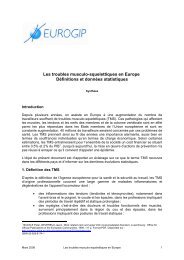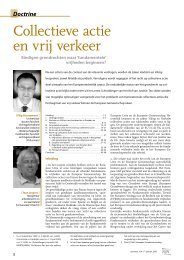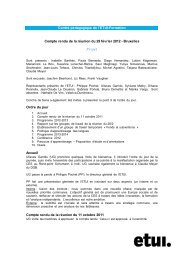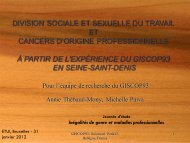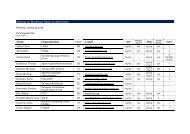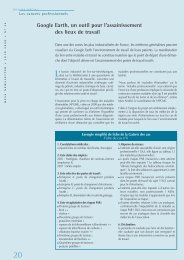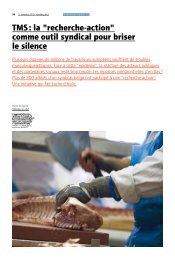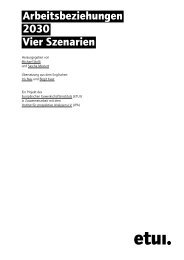Occupation and cancer - European Trade Union Institute (ETUI)
Occupation and cancer - European Trade Union Institute (ETUI)
Occupation and cancer - European Trade Union Institute (ETUI)
Create successful ePaper yourself
Turn your PDF publications into a flip-book with our unique Google optimized e-Paper software.
Acta Oncol Downloaded from informahealthcare.com by 212.35.100.66 on 04/06/11<br />
For personal use only.<br />
718 E. Pukkala et al.<br />
than 20% of men who have reached the age of 50<br />
have prostatic carcinoma that meets the histopathologic<br />
criteria for malignancy, but most of those<br />
<strong>cancer</strong>s seem to have a low potential for growth<br />
[107]. Therefore, the incidence must be interpreted<br />
in the context of prostate <strong>cancer</strong>-related diagnostic<br />
activity. This is exemplified by the Danish experience<br />
during the past three decades, where both the<br />
level of diagnostic activity <strong>and</strong> the prostate <strong>cancer</strong><br />
incidence have been lower than in the other Nordic<br />
countries [108,109]. Before the introduction of<br />
PSA testing in the late 1980s, trans-urethral resections<br />
of the prostate (TURP), widely applied as a<br />
treatment for benign prostate hyperplasia, were<br />
responsible for a large number of incidental findings<br />
of prostate <strong>cancer</strong>.<br />
The aetiology of prostate <strong>cancer</strong> is poorly understood.<br />
Consumption of red meat <strong>and</strong> dairy products<br />
is probably associated with an increased risk,<br />
whereas tomatoes <strong>and</strong> tomato products, especially<br />
those with high lycopene content, are associated<br />
with a reduced risk [110]. There are no established<br />
occupational risk factors, but cadmium, polychlorinated<br />
biphenyls <strong>and</strong> high electromagnetic fields<br />
have been suggested. The present results do not<br />
support an association with industrial occupations,<br />
as SIRs were not elevated among miners, chemical<br />
process workers, smelting workers, welders, painters<br />
or chimney sweeps. Furthermore, the contrasts<br />
between the highest <strong>and</strong> lowest SIRs were small.<br />
On the other h<strong>and</strong>, the present results support an<br />
association with diagnostic activity, as higher SIRs<br />
were observed for occupations that are related to<br />
higher social status <strong>and</strong> thus presumably better<br />
access to health care.<br />
/ 100 000<br />
15<br />
10<br />
5<br />
0<br />
Denmark<br />
Finl<strong>and</strong><br />
Icel<strong>and</strong><br />
Norway<br />
Sweden<br />
Testicular <strong>cancer</strong><br />
Incidence in the Nordic countries has been increasing<br />
over time <strong>and</strong> is nowadays about twofold in<br />
Denmark <strong>and</strong> Norway as compared with the other<br />
Nordic countries (Figure 34). The rates in Denmark<br />
<strong>and</strong> Norway are among the highest in the world.<br />
The highest significant excess risk of testicular<br />
<strong>cancer</strong> was found in physicians (SIR 1.48, 95% CI<br />
1.15 1.88), followed by artistic workers, religious<br />
etc. workers, printers <strong>and</strong> administrators (Table 48).<br />
The lowest risk was observed in forestry workers<br />
(0.70, 0.54 0.88), engine operators <strong>and</strong> welders.<br />
Sixty percent of the testicular <strong>cancer</strong>s in the<br />
present series are seminomas (http://astra.<strong>cancer</strong>.<br />
fi/NOCCA/Incidence/testis-seminoma). Physicians<br />
had the highest risk of seminoma with an SIR of<br />
1.48 (95% CI 1.07 1.99), followed by artistic workers<br />
(1.47, 1.06 1.99) <strong>and</strong> religious etc. workers<br />
(1.33, 1.14 1.56). The lowest SIRs were observed<br />
among cooks <strong>and</strong> stewards (0.56, 0.29 0.98) <strong>and</strong><br />
forestry workers (0.64, 0.47 0.86).<br />
The occupational category of administrators<br />
was the only one with a significantly elevated<br />
SIR of testicular non-seminoma <strong>cancer</strong> (1.21,<br />
1.04 1.42; http://astra.<strong>cancer</strong>.fi/NOCCA/Incidence/<br />
testis-non-seminoma). The only SIRs significantly<br />
below 1.0 were observed among engine operators<br />
(0.60, 0.41 0.84) <strong>and</strong> public safety workers (0.67,<br />
0.43 0.99).<br />
Comment. The mean age at diagnosis of testicular<br />
<strong>cancer</strong> in the Nordic countries is only 30 years,<br />
i.e., relatively low as compared with other <strong>cancer</strong><br />
sites. Many of the <strong>cancer</strong>s were diagnosed before<br />
the starting age of follow-up in the present study<br />
Men<br />
1945 1960 1975 1990 2005<br />
Figure 34. Age st<strong>and</strong>ardised (World) incidence rates for testicular <strong>cancer</strong> 1943 2005, by country. Modified from NORDCAN [49].




